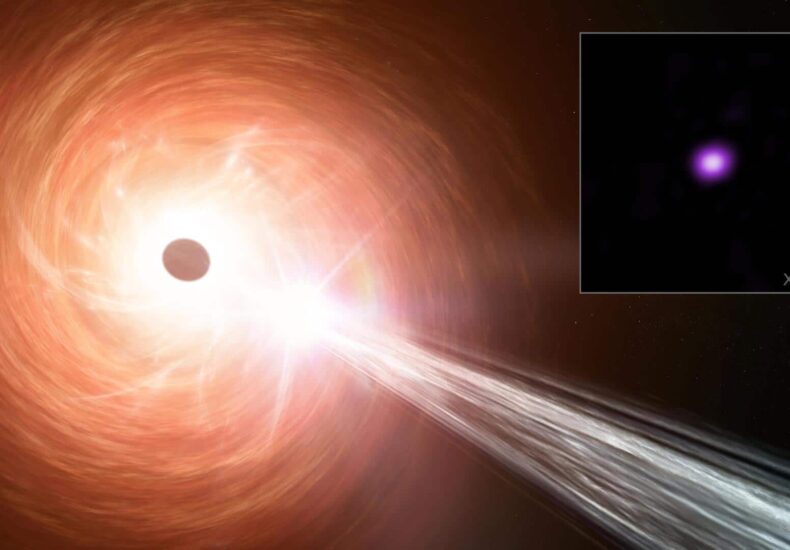
This might be one of the fastest-growing black holes ever
**This Might Be One of the Fastest-Growing Black Holes Ever**
*By Dwaipayan Roy | Sep 20, 2025, 04:21 pm*
A team of astronomers has discovered a black hole growing at one of the fastest rates ever recorded, according to NASA’s Chandra X-ray Observatory. This black hole, with a mass about a billion times that of our Sun, is located approximately 12.8 billion light-years from Earth. Observing it means we are looking back to just 920 million years after the universe’s birth.
### A Powerful Quasar in the Early Universe
The black hole powers a quasar—an incredibly bright astronomical object capable of outshining entire galaxies. The intense brightness comes from vast amounts of matter swirling around and falling into the black hole. This unique quasar, named RACS J0320-35, was first identified two years ago, but only recently confirmed to be growing at an extraordinary rate using 2023 data from Chandra.
### Breaking the Eddington Limit
Chandra’s X-ray data suggest that this black hole is growing at a rate exceeding the typical growth limit for such objects, known as the Eddington limit. The Eddington limit represents the maximum rate at which matter can fall into a black hole before the radiation pressure pushed outward counters the gravitational pull.
Luca Ighina, lead researcher at Harvard & Smithsonian’s Center for Astrophysics, remarked, “It was a bit shocking to see this black hole growing by leaps and bounds.”
### Understanding the Eddington Limit
When matter spirals into a black hole, it heats up and emits intense radiation across many wavelengths, including X-rays and visible light. This radiation generates pressure that can push back on falling material. The Eddington limit is the balance point where this radiation pressure equals the force of gravity. Crossing this limit indicates exceptionally rapid growth.
### Implications for Black Hole Formation
Typically, black holes growing below the Eddington limit are thought to have formed with initial masses around 10,000 times that of the Sun. This starting point explains how some black holes reach billions of solar masses in under a billion years after the Big Bang.
However, because this black hole’s growth rate is 2.4 times the Eddington limit, it might have formed more conventionally, beginning with a mass less than 100 solar masses but growing at a highly accelerated pace.
### Estimating Growth Rate with X-ray Spectra
Researchers estimated the black hole’s growth rate at between 300 and 3,000 solar masses per year by comparing theoretical models with the X-ray spectrum captured by Chandra. The spectral data closely matched expectations for black holes growing beyond the Eddington threshold.
Additional optical and infrared observations support this interpretation, confirming that RACS J0320-35 is gaining mass faster than previously thought possible.
—
This discovery challenges existing views on how early supermassive black holes formed and evolved, opening new avenues to understand the dynamics of the early universe.
https://www.newsbytesapp.com/news/science/astronomers-discover-fastest-growing-black-hole-in-early-universe/story
You may also like

Ancient water in protoplanetary disk is older than its star

Last solar eclipse of 2025 today: How to watch
You may be interested
Last solar eclipse of 2025 today: How to watch
**Last Solar Eclipse of 2025 Today: How to Watch** *By...
Ancient water in protoplanetary disk is older than its star
Astronomers have discovered ancient water in the planet-forming disk surrounding...
 The New York Times
The New York Times
- Trump Organization Is Said to Be in Talks on a Saudi Government Real Estate Deal 2025 年 11 月 16 日 Vivian Nereim and Rebecca R. Ruiz
- Adam Sandler Is the Light We Need 2025 年 11 月 16 日 JoAnna Novak
- The Laptop That Ate Your Child’s Classroom 2025 年 11 月 16 日 Jean M. Twenge
- What’s More Dangerous than India’s Frequent Heat Waves? Heat Stress. 2025 年 11 月 16 日 Anupreeta Das and Anindito Mukherjee
- 4 Dead After Suspected Migrant Boat Overturns Near a San Diego Area Beach 2025 年 11 月 16 日 Mark Walker
- How Many People Die in India From Hot Weather? Nobody Really Knows. 2025 年 11 月 16 日 Anupreeta Das
- Storm Pounds Southern California With Heavy Rains and Some Flooding 2025 年 11 月 16 日 Amy Graff
- U.S. Border Patrol Launches Operation in Charlotte, N.C. 2025 年 11 月 16 日 Eduardo Medina and Bernard Mokam
- Former Fed Official Violated Trading Rules, Disclosures Show 2025 年 11 月 15 日 Colby Smith
- Fetterman Is Released From the Hospital After a Fall 2025 年 11 月 15 日 Billy Witz
Leave a Reply